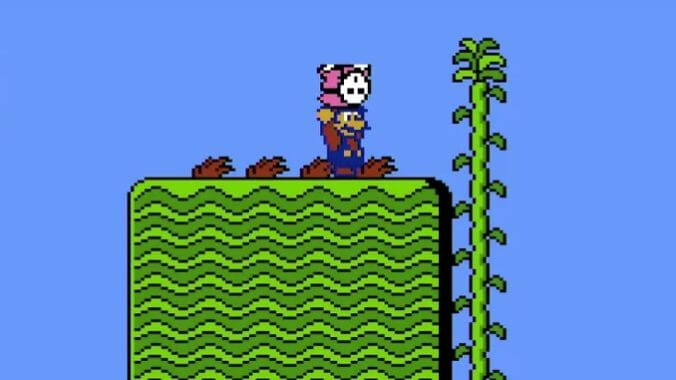The Impact of the American Super Mario Bros. 2 Is Still Felt 35 Years Later
It might not be a "real" Mario game to some, but the US Super Mario Bros. 2 influenced the future direction of all Mario platformers

Ever since it was released for the NES in America 35 years ago today, Super Mario Bros. 2 has more often than not been the butt of a joke. Videogamedunkey includes it as his game of the year in his annual best-of list as a gag. People reflexively dismiss it as an impostor in the series any time it’s brought up; the trite interjection, “Well, you know Super Mario Bros. 2 isn’t actually Super Mario Bros. 2” feels borderline Seinfeldian at this point. Unfortunately, that’s often where the discussion begins and ends. It deserves better.
Those with a purist, borderline fetishistic, bent will tell you that it isn’t a Mario game at all, instead favoring the unbearably difficult, Super Mario Maker troll-level-gone-wrong Japanese version of the game (dubbed The Lost Levels in its Stateside release) as the one true Super Mario Bros. 2. The US version may technically be a re-skinned port of the game Doki Doki Panic, but it’s a significantly better game than the original 2 and helped to set a distinct tone for the franchise’s future. Its towering verticality, surprisingly complex secrets, tight controls, multiple playable characters, and clever level design put it far more in line with the spirit of what we know Mario as today.
In true Super Mario Bros. spirit, Mario 2 is rarely content to stick with one idea for too long. Presenting you with puzzle-like platforming challenges that continually push the envelope, there’s so much raw creativity on display here. It introduces idea after idea before interweaving them and pushing them in a new direction and then moving on. One level might introduce a magic flying carpet while another might completely reframe the way the picking mechanic works, letting you dig your way through a cave.
Some connections go beyond the spiritual, though. One of Super Mario Bros. 2’s trademarks is its doors, which open up to different rooms based on the level around it. Some reveal an environmental puzzle while others house power-ups or opportunities to get extra lives. The puzzles are very similar to truncated versions of Super Mario World’s Ghost House levels, which often take similar cues from their environments.
Levels also divert from Super Mario Bros.’ inflexible left-to-right pattern. Goals lie in every direction; sometimes you have to climb, dig, fly, or even pass through a number of doors before finding the boss fight at the end of a level. Playing the 2D Mario games in the order they were released further reveals Super Mario Bros. 2’s legacy. Sure, the first Super Mario Bros. is a wildly inventive display that continues to define the platforming genre to this day, but aside from the occasional Warp Zone or secret pipe or invisible block, its focus lies on platforming and platforming challenges. Mario 2, on the other hand, prods the player to explore and break the firm left-to-right rules found in the original, dangling bigger, more fleshed-out secrets.